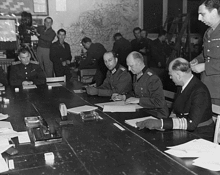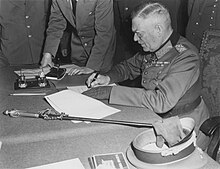German Instrument of Surrender
The German Instrument of Surrender was the legal instrument by which the High Command of the German Armed Forces surrendered simultaneously to the Supreme Commander of the Allied Expeditionary Force and to the Soviet High command at the end of World War II in Europe.
First Act

The first Instrument of Surrender was signed at Reims, France, at 02:41 hours on 7 May 1945.
The unconditional surrender of the German armed forces was signed by Generaloberst Alfred Jodl, on behalf of the Oberkommando der Wehrmacht (German language: High Command of armed forces) and as the representative for the new Reich President, Grand Admiral Karl Dönitz.
This Instrument of Surrender applied to all military forces on land, at sea, and in the air who were at that point of time under the control of the Oberkommando der Wehrmacht (OKW). Although the military commanders of most German forces obeyed the order to surrender issued by the German Armed Forces High Command not all commanders did so. The largest contingent not to do so were Army Group Centre under the command of Field Marshal Ferdinand Schörner who had been promoted to Commander-in-Chief of the Army on April 30 in Hitler's last will and testament. Like many institutions in Nazi Germany the control of the Army was split between the OKW and the German Army High Command (OKH). By 1945 the OKW commanded all German forces in every theatre apart from those on the Eastern Front which were under OKH control and which, before his suicide, had reported directly to Hitler. So it was not clear if Schörner was under the command of OKW on May 8 or if Dönitz, or von Krosigk, needed to order Schörner to surrender. In the end it was resolved by force of arms. On May 8, Schörner deserted his command and flew to Austria and the Soviet Army sent an overwhelming force against Army Group Centre in the Prague Offensive forcing all German units in Army Group Centre to capitulate by May 11 [1] (Soviet troops entered Prague on 12 May). Pursuant to this Instrument of Surrender, the German High Command issued orders to all forces under its command to cease active operations at exactly 23:01 hours Central European Time of May 8 1945.[2] Thus, this Instrument of Surrender legalized unconditional surrender of all armed forces under the German High Command, officially ending combat in Europe.
The Soviet Union's only representative in Rheims was General Ivan Susloparov, the Military Liaison Mission Commander. General Susloparov's scope of authority was not entirely clear, and he had no means of immediate contact with the Kremlin, but nevertheless decided to risk signing for the Soviet side. However, he noted that it could be replaced with a new version in the future.[3] Stalin was indeed displeased by these events. He believed that the German surrender should have been accepted only by the envoy of the USSR Supreme command, and insisted the Rheims protocol be considered preliminary, with the main ceremony to be held in Berlin, where Marshal Zhukov was at the time.[4]
Second Act


The second Act of Military Surrender was signed, shortly before midnight, on May 8[5] in the outskirts of Berlin, Germany. The signing ceremony took place in a villa in an eastern suburb of Berlin called Karlshorst, where the German Russian Museum is located today. [1] The representatives of the USSR, the United Kingdom, France and the United States arrived shortly before midnight. After Zhukov opened the ceremony, the German command representatives headed by Wilhelm Keitel were invited into the room, where they signed the final German Act of Unconditional Surrender entering into force at 23:01 Central European Time.
Representatives:
- Soviet Union: Marshal Georgy Zhukov on behalf of the Supreme High Command of the Red Army
- United Kingdom: Deputy Supreme Commander of the Allied Expeditionary Force, Marshal of the Royal Air Force Arthur William Tedder
- France: General Jean de Lattre de Tassigny, Commanding First French Army
- United States: General Carl Spaatz, Commanding United States Strategic Air Forces
- Nazi Germany:
- Admiral Hans-Georg von Friedeburg as Commander-in-Chief of the Kriegsmarine
- Colonel-General Hans-Jürgen Stumpff as the representative of the Luftwaffe
- Field Marshal Wilhelm Keitel as the Chief of Staff of the Oberkommando der Wehrmacht
Soviet Union did not allow the participation of Poland as representative.
Postscript
Karl Dönitz continued to act as head of state, but his Flensburg government (so-called because it was based at Flensburg and controlled only a small area around the town) was not recognised by the Allied powers and was dissolved when its members were captured and arrested by British forces on May 23, 1945 at Flensburg. The Allies had a problem, because they realised that although the German armed forces had surrendered unconditionally, SHAEF had failed to use the document created by the "European Advisory Commission" (EAC) and so the civilian German government had not. This was considered a very important issue, because just as the civilian, but not military, surrender in 1918 had been used by Hitler to create the "stab in the back" argument, the Allies did not want to give a future hostile German regime a legal argument to resurrect an old quarrel. Eventually they decided not to recognise Dönitz's Government and to sign a four-power document instead, creating the Allied Control Council which included the following:
- The Governments of the United States of America, the Union of Soviet Socialist Republics and the United Kingdom, and the Provisional Government of the French Republic, hereby assume supreme authority with respect to Germany, including all the powers possessed by the German Government, the High Command and any state, municipal, or local government or authority. The assumption, for the purposes stated above, of the said authority and powers does not effect the annexation of Germany. [US Department of State, Treaties and Other International Acts Series, No. 1520.][6][7]
On 5 July 1945 the four-powers signed the document in Berlin and the de facto became the de jure.[8] This imposition was in line with Article 4 of the Instrument of Surrender that had been included so that the EAC document, or something similar, could be imposed on the Germans after the military surrender. Article 4 stated that "This act of military surrender is without prejudice to, and will be superseded by any general instrument of surrender imposed by, or on behalf of the United Nations and applicable to GERMANY and the German armed forces as a whole."[9]
In July/August 1945 the Allied leaders planned the new postwar German government, resettled war territory boundaries, ordered German demilitarization, denazification and settlements of war reparations at the Potsdam Conference.
See also
- End of World War II in Europe
- Debellatio
- Nuremberg Trials
- Morgenthau Plan
- Japanese Instrument of Surrender
References
 Works related to German Instrument of Surrender at Wikisource
Works related to German Instrument of Surrender at Wikisource- Earl F. Ziemke "The U.S. Army in the occupation of Germany 1944-1946" Cenrer of Military History, United States Army, Washington, D. C., 1990, Library of Congress Catalog Card Number 75-619027
- The Memoirs of Georgy Zhukov. Chapter 22: Unconditional Surrender of Nazi Germany Template:Ru icon
Footnotes
- ^ Earl F. Ziemke, Battle for Berlin: end of the Third Reich, p. 134. In: A.J.P Taylor: The Second World War, p. 223.
- ^ As it was summer, this was probably 0001, 9 May local German summer time.[citation needed] During the summers of World War II, Britain was on British Double Summer Time which meant that the country was ahead of CET time by one hour. This means that the surrender time in the UK was "effective from 0001 hours on 9 May". RAF Site Diary 7/8 May
- ^ Article 4 of the Rheims surrender document stated that "This act of military surrender is without prejudice to, and will be superseded by any general instrument of surrender imposed by, or on behalf of the United Nations and applicable to GERMANY and the German armed forces as a whole."
- ^ Memoirs of Georgy Zhukov p.??
- ^ Earl F. Ziemke References CHAPTER XV:The Victory Sealed Page 258 last paragraph
- ^ A scanned image of the relevant page of the agreement
- ^ Earl F. Ziemke References CHAPTER XV:The Victory Sealed Page 263 first paragraph. The verb "effect" is misquoted here as "affect"; see the previous footnote for a scan showing the correct wording.
- ^ Earl F. Ziemke References CHAPTER XV:The Victory Sealed Page 263
- ^ Earl F. Ziemke References CHAPTER XV:The Victory Sealed Page 258
